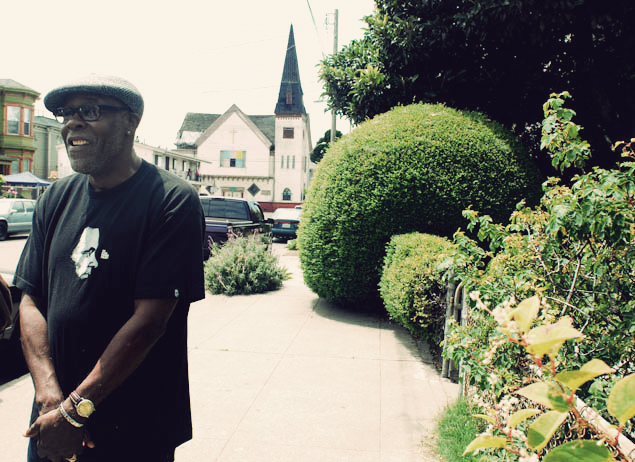
There are few external markers to show you what David Hilliard knows about certain places in Oakland. He knows where to find the bullet holes that still pockmark a house, puncture a fence railing. As Hilliard tells it, he was hiding in a house nearby, one night in 1968, shortly after the murder of Martin Luther King, Jr. He listened as some 1,900 rounds were emptied by the police force.
Two Black Panther Party members had ducked into a garage. Only one left alive—running out to the police stark naked to show he was free of weapons. It was Eldridge Cleaver. Hilliard explained that the penitentiary had already taught him the nuances of confronting authority. Bobby Hutton, on the other hand, was shot dead—he was 17 years old.
But this wasn’t where the tour started. Along with a small group, I met the original Chief of Staff of the Black Panther Party, David Hilliard, by DeFremery Park at the West Oakland public library. Our first stop was on Market and 55th, where the first draft of the Panthers’ 10-point-plan was written. It was also the site of two streetlights the black community called to be installed there after children had been struck by passing cars. Though Hilliard advised me it wasn’t exactly as depicted in “Mario’s movie”—Mario Van Peeble’s 1995 drama Panther—there were party members involved in the effort.
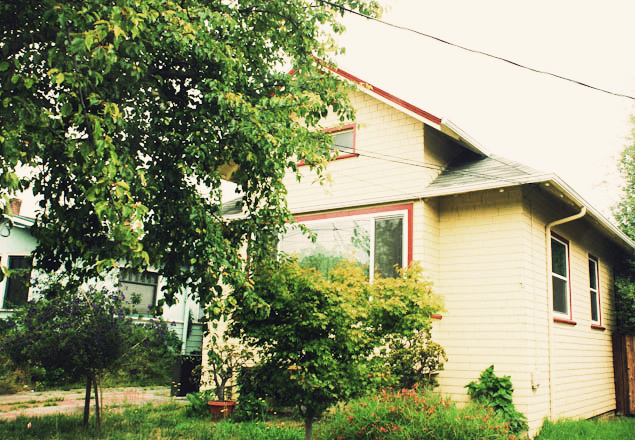
Our next stops were clustered in North Oakland around Martin Luther King Jr. Blvd, specifically the stretch of it with an elevated BART line. We stopped at Bobby Seale’s house, a beige home on 57th Street that served as an informal meeting place where he, Huey Newton, and others would congregate. Hilliard pointed across MLK to the former location of Merritt College.
“That’s where the Black Panther Party started, not in the street,” he said. “They closed it down, because they said it was being used as an organizing base. And they were right!” He described Merritt College as a hotbed of political activity, and a place where young black people in Oakland were turning to for learning and inspiration—and in turn getting lit up with ideas.
Hilliard emphasized the depth and variety of practical programs the Panthers put into practice or had planned for Oakland. “Most people know about the free breakfast program,” he said. “We had 60 programs.” Hilliard described a free health care program, modeled on the Free Clinic in Haight / Ashbury, and a partnership with a hospital where the Panthers worked to test 50,000 African Americans for sickle-cell anemia.
“We were the youth of America, just young college students in our teens and twenties,” Hilliard said. He paused, looking back over the decades, and went on with an air of detachment, almost amazed to recount it. “Bobby Seale and Eldridge Cleaver… they were the old guys. They were like 30, 31.”
Here, as throughout the Black Panther Legacy tour, Hilliard gave time and attention to describing his boyhood friend and political comrade, Huey Newton. Newton’s dynamic presence and leadership galvanized the Party and helped launch it to national and international notoriety—but it’s clear that his influence made itself felt most significantly on the people close to him.
“What people don’t picture is Huey with a gun in one hand and a law book in the other,” Hilliard said. He described Newton as a fiercely intelligent, but startlingly young person who in his early 20s, articulated the problems and struggles of the black community and a radical plan for action. At the time when the Black Panther Party was formed, Newton was a law student, well acquainted with California legal code pertaining to firearms. As a leader, he was strict and cautious, advocating the Panthers adhere to the law in their community self-defense operations.

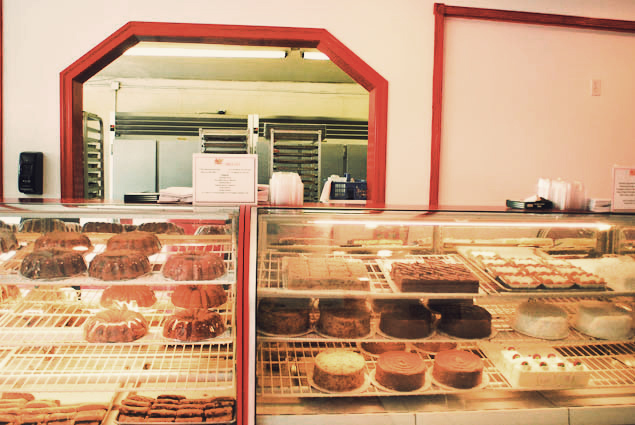

We went on to the “It’s All Good Bakery,” (not to be confused with the troubled “Your Black Muslim Bakery” elsewhere in Oakland). This was the first headquarters of the Black Panther Party, where, among other things, the newsletter was organized and produced. Circulation reached 270,000 a week at its highest, with distribution across the nation and the world—though distribution was continually hampered by sabotage, Hilliard said, by the FBI.
The BPP newsletter promoted its ideas and fiery rhetoric, and lent support to other causes including Latino mobilization in San Francisco’s Mission District and early advocacy of the womens’ movement and gay rights. Hilliard said it was French author Jean Genet—an active supporter of the BPP, who Hilliard had fond stories of touring the country with—who inspired Huey Newton to go public on the issue of gay rights. As Hilliard described it, the BPP was at least as inclusive as it was uncompromising and militant.
After the bakery, we paused at a corner on 47th and West, stopping by Hilliard’s childhood home, and then by Newton’s old house. He recalled walking to school with Newton as young boys, and how Newton was the studious one, who always had his books with him. “The only reason I was involved with the Black Panther Party was because I knew him,” Hilliard said. Passing by 45th and MLK, he pointed out the second Party headquarters—this one where the famous picture of Huey Newton sitting in a wicker chair with a spear and a rifle was taken.
We headed into West Oakland and past McClymonds High School, where Hilliard attended. A semi-industrial community where warehouse-to-condo converts now sit adjacent to vacant lots and houses—some boarded up, some well worn, some well-kept. The black community is hanging on here as well as new arrivals (many of them white). It was also a neighborhood where Hilliard used to work, in a sausage factory as a young man. “Here’s where you step into some bloody footprints,” Hilliard said as we got out of the van in front of the house where Little Bobby Hutton was killed.
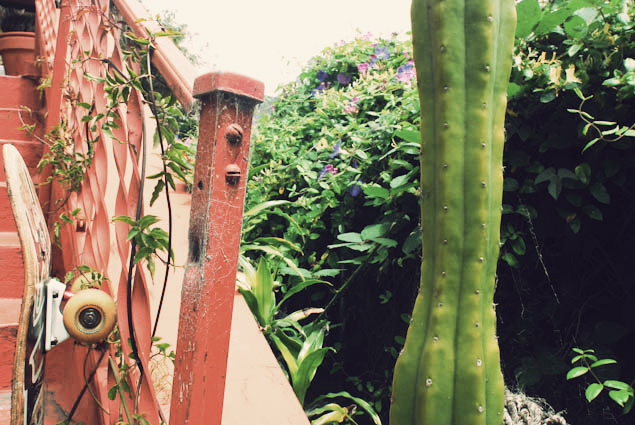
The final place Hilliard took us to was another sunlit scene where on an Oakland sidewalk, a man he knew had been shot. At 9th and Center, Huey Newton’s own story came to an end. In a tragic twist of irony, the young man who shot Huey Newton did it for no other reason than to receive street status—a young man who had grown up in awe of the Panthers, and had himself been one of the beneficiaries of their free breakfast program. Hilliard spoke bitterly of the youth violence that pitted gangs from one part of Oakland against another, and said it hadn’t been that way when he was growing up.
The Black Panther Legacy tour is a unique experience for many reasons, but first of all because of its guide—David Hilliard. He’s a reflective and often vulnerable host, sharing memories and experiences that were traumatic and painful. Hilliard cast his own story as a journey to recovery. After a prison stint related to his political activities, he found himself disillusioned and strung out on drugs—at least in part to deal with the trauma of what he’d experienced. The clarity he achieved by kicking his dope habit is the lens through which he seems to look at the final scene of Newton’s life: his friend had been devoured by the street life Hilliard narrowly escaped, a grim reality which they’d both fought to change.
In a city that still struggles with poverty, disenfranchisement, racial divisions, violence, and addiction, the story of the Black Panther Party urgently needs to be understood—the idealism, the intensity, the useful ideas along with the impractical ones. Hilliard knows the significance of the history he lived through. In conducting his tours of Oakland he’s opening the door for whoever wants to get acquainted with an essential chapter in the history of his city, one that is also a chapter in the civil rights struggle and the turmoil of an era—bloody footprints and all.

Huey Newton (1948 – 1989)




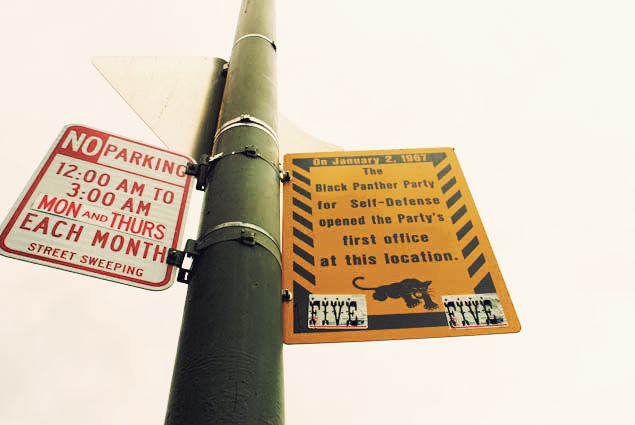



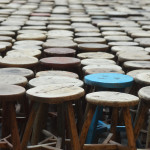
Memories!! I resided in Richmond,CA while my husband was in Southeast Asia subscribed to the newsletter & attended Panther meetings in Oakland on Friday nites at an Episcopal church headed by a young mininster who supported the Panthers and their causes. The meetings were well attended positive and informative.
Would love to know the name of the minister and the church which should be part of the history.
Memories!! I resided in Richmond,CA in 1968-1969 while my husband was in Southeast Asia, subscribed to the newsletter & attended Panther meetings in Oakland on Friday nites at an Episcopal church headed by a young mininster who supported the Panthers and their causes. The meetings were well attended positive and informative.
Would love to know the name of the minister and the church which should be part of the history.
I’m honored to be writing to an American Hero. I’m white, but, when I moved to S.F., in ’68, I met a couple panthers, with Berets and rifles, on a bus, and after seeing that no one seemed to be panicked, my girfriend and I walked to the back and sat down. One Panther broke the ice by asking for a cigarette, and explained how they were the people’s police, having had protected a couple sailors from being beat up and educating some brothers of their rights, while being interogated by police. I bought every edition of the Panther Paper,since, and went to every event posible; when Kathleen spoke across the street from the FBI office, when Bobby Seale spoke so brilliantly, in about 30 seconds, at an Arlo Guthrie/Ani-War rally, that left the whole crowd stunned and jolted back to reality, Huey’s Birthday Party, at a large hall in Oakland, Golden Gate Park when you were arrested for “threatening the life of the President”, when you, merely, said; you would take up arms against anyone who stood in your way to be an equal and free American, even if it was the President of the United States. My girlfriend and I went to your S.F. office, in solidarity, when Pacifica Radio put out a call for people to show up to prevent the FBI from carrying out a massacre. I thank you and the men, women and children Panthers who sacrificed so much, for the rights of Blacks and every other race in our country. I’ve defended you and educated many people of your work and courage, ever since. The pride and self respect you instilled was/is such an act of beauty. Power to the People, Tom Frazee
To the lady name CONNIE MARSHALL THE MINISTER NAME WAS FATHER O,NEAL THE NAME OF THE CHURCH IS ST. AUGUSTINE ON 27 WEST STILL THERE MY GRAND DAUGTHER WHEN THERE FOR CHILD CARE I WENT THERE FOR BREAKFAST AN LIBERATION SCHOOL.I,M AM THE OLDEST SON OF DAVID HILLIARD AN PATRICIA HILLIARD
I have many warm memories of our families interacting during these trying times and through the numerous struggles the Party sheltered and protected us. God Bless you and your entire family Dennis. Email me at: l.cook@att.net.
Hi Dennis,
I read this post and everyone’s replies with great interest. I am working as the curator for a project called “Patient No More!” that is exploring the historic Sit In of the San Francisco federal building by people with disabilities in April 1977 and trying to find out more about the support provided by the Black Panthers. Two members were inside the Sit In – Bradley Lomax and his attendant Chuck Jackson, and though Brad has sadly passed away, I think Chuck may still be around. If anyone has any information or memories I would love to talk and find out more. We will be recording some new oral histories and a new perspective on this momentous local event. For more details take a look at the official website: http://longmoreinstitute.sfsu.edu/patientnomore
Mr. Hilliard: I am a History Day mentor for a student researching the Panther Free Breakfast Program. Very easy to find information on the negative light the Panthers are too often remembered in but difficult to find sound information on their community services works – an untold story. My student is seeking email or phone interviews with persons directly involved in the Breakfast programs. Would be grateful if you would be willing to contact me regarding potential contacts or information.
Thank you for sharing the Black Panther history in Oakland. I now live in Maryland and read about your tour via AOL’s Black Voices. When I relocated to Oakland in 1972, it was challenging trying to understand the unrest that erupted from what appeared as an easy going city until I begin experiencing its strong police presence. I’m a painter of fine art and owner of a greeting card company and had the pleasure of your company at several of my shows. Huey Newton’s former wife has followed my art and everywhere I travel people approach me thinking I’m Angela Davis. As a baby boomer attending Morgan State University, an historical Black College in Baltimore, coupled with having the honor of living in Oakland, the legacy of the Black Panther Party must be told for generations to come. Continue on.
I just want to say i appreciate our folks, The BPPFSD to display what our Creator has given us Black folks from the beginning which can never be taken away by man, Intelligence and Courage. I am from New York and nownlive in the Bay Area. Can someone call me in regards to a tour, getting together wit ex-panthers (i hate saying ex because when ur a Panther, your a Panther). My number is 646-327.5445
“Passing by 45th and MLK, he pointed out the second Party headquarters—this one where the famous picture of Huey Newton sitting in a wicker chair with a spear and a rifle was taken.”
What is the exact address? My friends bought a house at 4423 MLK and say this was one of the Panther’s headquarters. Are they correct?
The Oakland Museum lists the Black Panther Party Office #2 at
4419 Martin Luther King Jr. Way.
Hi, I would like to go on the panther tour, but can’t seem to find any information online. Please help!
Hi! I have read this beautiful article and some of the comments. I’m doing a thesis paper on the Black Panther Party, but having trouble getting information about them. All that is required is an real life story they have seen or experienced personally with the Black Panther Party. Please help!
Do these tours still happen?
Does anyone know if these tours still happen? I see the comment above unanswered and i’m hoping someone lets us know…
RO CHAPEL MO.ATTORNEY NAACP STATE LEADER WARNS BLACK MOTORISTS AND TOURISTS WATCH YOUR BACK AND YOUR DOLLARS IN MISSOURI
LEGAL SEARCH: ON BEHALF OF THE MATTYE E.BLAKENEY FAMILY FROM THE GREAT STATE OF CALIFORNIA OAKLAND SEASIDE MONTEREY-LOVING DEVOTED MOTHER CIVIL RIGHTS ACTIVIST EDUCATOR COMMUNITY ORGANIZER CONGRESSIONAL AWARD RECIPIENT WORLD TRAVELER
LEON CHRISTOPHER vs KC STAR NEWSPAPER co.EEOC/MCHR DISCRIMINATION CIVIL SUIT-MIRRORS 1992 FILM DISCLOSURE INVOLVING SEX CHARGE/PHONE RECORDS COUNTERCLAIM EVIDENCE-SEEMS A JURISDICTIONAL ISSUE HAS STALLED THE CASE AND THE SETTLEMENT-IN WHAT SHOULD BE A SLAM DUNK CASE-
GOOGLE SEARCH: KC 2001 PRECIOUS DOE/ERICA GREEN MURDER-THE OFFICIAL ACCOUNT BY BROADCASTERS MAY BE FALSE-SPECIFICALLY IN REGARDS TO THE COMPOSITE SKETCH AND THE DON’T ASK ME HOW LOOKALIKE BUST
REVIEW THE CASE WITH THESE STARTLING FACTS IN MIND
WHY WOULD THE GOVERMENT AND THE NICE PEOPLE AT THE DOJ/DOD COMMISSION A SECOND BUST TO REPLACE THE FIRST AND THE LOOK ALIKE SKETCH RELEASED BY THE POLICE
ALTHOUGH WIDELY REPORTED THE CHILD’S SKULL WAS MISSING THE FOCUS OF A THREE DAY SEARCH BY AUTHORITIES AND CIVILIANS-THAT DID’NT STOP OR EVEN SLOW FOX AND OTHERS FROM CIRCULATING WITHIN MERE HOURS OF FINDING HER REMAINS WHAT THEY DESCRIBED ON THE EVENING IN QUESTION AS A SOCALLED COMPUTOR GENERATED COMPOSITE SKETCH OF THE HEADLESS MURDER VICTIM- GO FIGURE?!
TECHNOLOGY FRAUD:COMPUTORS CAPABLE OF RENDERING IMAGES OF THE HUMAN FACE FROM SCRATCH WITH THE DETAILED LIFE LIKE REALISM DEPICTED IN THE COMPOSITE SKETCH I REGRET TO INFORM YOU-(Y’ALL BEEN HOODWINKED BAMBOOZLED)-DID NOT EXIST AT THAT TIME-ONLY IN RECENT YEARS HAS IT BEEN POSSIBLE THOUGH REQUIRES SPECIAL SOFTWARE AND HARDWARE TO ACCOMPLISH -DO NOT TAKE MY WORD FOR IT-CHECK IT OUT -A NUMBER OF AGENCIES ARE INVESTIGATING -CAN WE COUNT ON YOU ??